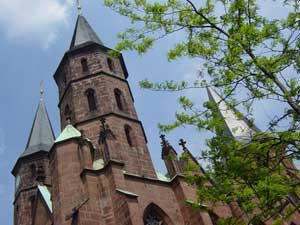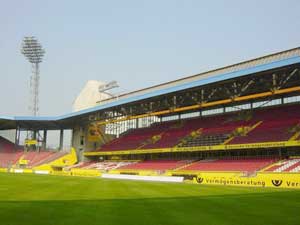
Germany 2006 FIFA World Cup VenuesFIFA World Cup Host Cities - KAISERSLAUTERNKaiserslautern city profile
Construction of the foundation church commenced in the second half of the 13th century. St. Martin's Church was built by the Franciscans at the beginning of the 14th century. But the cultural history of the city extends back to the fifth millennium B.C. The historical origin of today's city is assumed to have been in the 4th century AD. The earliest available documented indication of the city's existence is from around 830, and the first document mentioning it dates from 882. Emperor Otto III granted Kaiserslautern the right to hold markets in 985, and in 1152 Emperor Barbarossa had the imperial palace (Kaiserpfalz) named after him erected there. In 1848 the city was connected to the railway system. This marked the beginning of its ascent as a centre of industry (textiles, ironworking and machine construction). After World War II the Americans used Kaiserslautern and the surrounding region as a major military base. Even today, more than 40,000 U.S. soldiers and their families are stationed here, making the military community of Kaiserslautern, which extends to Ramstein airbase, the largest U.S. forces military base outside of the United States. Kaiserslautern is a football city. Its team, 1. FC Kaiserslautern, has made the city famous throughout Europe - and not just in recent years with its successes under coach Otto Rehhagel who brought the "Red Devils" back into the Bundesliga just after they had been relegated in 1996 and led them to victory as German Champions in 1998. The team from the Betzenbergstadion had already won the championship in 1991, and were German Cup winners in 1990 and 1996. And then there are the unforgettable achievements of the 1950's with Fritz and Ottmar Walter, when the Kaiserslautern team formed the backbone of Germany's 1954 World Cup winning team with five players. The club was German Champion in 1951 and 1953. 30,000 registered members in more than 100 sports clubs are a clear indication that sport is very much alive here. There are 40 club-owned sports facilities with 70 pitches and 56 sports, gymnastics and multi-purpose centres. The centre of sporting life is the ultra-modern Fritz-Walter-Stadion, formerly the Betzenbergstadion. Major Events at the Kaiserslautern Fritz-Walter-Stadion
Kaiserslautern stadium profilePopulation: 100,000Stadium: Fritz-Walter-Stadion Project: Extension Investment: 48.3 million Euro Gross Capacity: 43.450 Total Seating Capacity: 39.820 (*) Purchasable Ticket Capacity (**)
Changing times and tastes are visible in the architecture at the purpose-built football arena, home to 1. FC Kaiserslautern. The ground has a distinctly modular feel thanks to a series of additions and extensions over the decades. Reconstruction for the FIFA World Cup was completed in November 2005. The final phase of the project comprised extensions to the West and South stands, and reconstruction of the North stand. A media tower and VIP tower will occupy the northern corners of the ground. 1. FC Kaiserslautern boast one of German football's richest and most colourful histories. The 'Red Devils' have won the German championship on four occasions, most recently and uniquely in Bundesliga history as a promoted club in 1997-8 under coach Otto Rehhagel. On 6 June 2004, as part of the festivities to mark the 50th anniversary of the 'Miracle of Bern', Kaiserslautern hosted an international between Germany and Hungary. Financing: (*) "Total Seating Capacity" means the Gross Capacity less the seats unavailable for use due to restricted views and security/contingency reserves for the 2006 FIFA World Cup. This capacity is estimated and may change once these deductions are finally determined.
|
|||||||||||||||||||||||
Recommended Sportsbook
Bookmaker Sportsbook is a recognized sports betting leader since 1985. BookMaker provides safe, legal, and secure betting on major sporting events, as well as horse racing, casino, and poker entertainment, from any location in the world, 24 hours a day 7 days a week. Bookmaker is the number one legal online sports betting and entertainment center of America. Bonded and fully licensed by the Government of Costa Rica. With a reputation like this everyone should have an account.
Bookmaker covers all needs for any real gambler. If you do not have an account with Bookmaker you are making a very big mistake. Signing up now is better than ever as gives you the best bonuses available. With an array of bonuses and the best reputation, Bookmaker is a must have for A list sportsbook betting fans. Sign up today!
 Kaiserslautern is a "city in the woods" in the midst of the Palatinate Forest, one of Germany's largest forest areas. Kaiserslautern is also a city with a long history. Traces of the city's past can be found all over the historic town centre. Count Palatinate Johan Casimir erected a renaissance castle here in 1571.
Kaiserslautern is a "city in the woods" in the midst of the Palatinate Forest, one of Germany's largest forest areas. Kaiserslautern is also a city with a long history. Traces of the city's past can be found all over the historic town centre. Count Palatinate Johan Casimir erected a renaissance castle here in 1571.  The Fritz-Walter-Stadion opened its doors in 1920. It is situated on the Betzenberg, a 40 metre sandstone hillock at the heart of the Palatinate metropolis, and was named after the legendary German 1954 FIFA World Cup-winning captain in 1985.
The Fritz-Walter-Stadion opened its doors in 1920. It is situated on the Betzenberg, a 40 metre sandstone hillock at the heart of the Palatinate metropolis, and was named after the legendary German 1954 FIFA World Cup-winning captain in 1985.